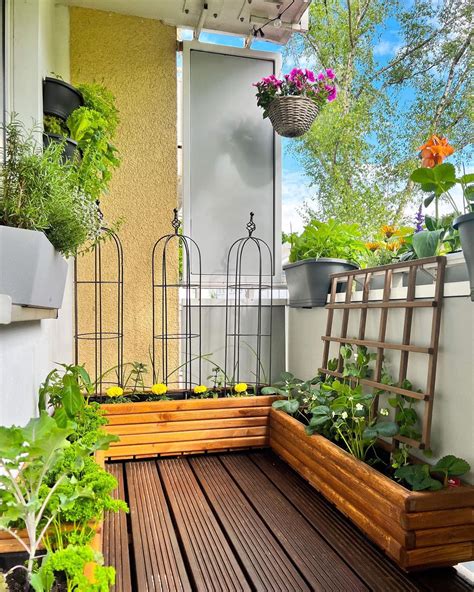How to Plan and Design the Perfect Balcony Garden for Your Space
Balcony gardening offers a unique opportunity to transform a small outdoor space into a lush green oasis. Whether you’re working with limited square footage or an expansive terrace, this guide will help you plan, design, and organize a thriving garden that reflects your personal style while accommodating the practical needs of plants. With the right layout, containers, and sunlight considerations, you can enjoy a productive and beautiful garden all year round. In this comprehensive article, we’ll cover key concepts, practical tips, historical context, and modern insights to make your balcony garden a success.
Key Concepts for Balcony Garden Design
Before diving into the specifics, let’s look at some key concepts that are essential to planning your perfect balcony garden.
- Space Utilization: Making the most out of limited space is crucial. Vertical gardening, hanging pots, and tiered plant stands help maximize your available square footage.
- Light Exposure: Understand how much sunlight your balcony gets. Sunlight affects plant selection, growth, and layout. Plants are classified based on their light requirements, such as full sun, partial shade, or full shade.
- Plant Selection: Choose plants suited to your balcony’s microclimate. Consider the amount of sunlight, wind exposure, and seasonal changes.
- Container Gardening: Using containers allows for flexibility in arrangement and plant types. Different plants require different types of containers for proper growth and health.
- Watering Systems: Planning an efficient watering system—whether automated drip irrigation or a simple watering can—will save time and help maintain plant health.
- Growth Patterns: Pay attention to how plants grow and plan your space accordingly. Some plants will need more room to sprawl or climb.
- Design Aesthetics: Consider the visual appeal of your garden. Balance color, height, and textures to create an aesthetically pleasing space.
Historical Context of Balcony Gardening
Balcony gardening has evolved over centuries. It began as a way to utilize limited urban space for food production, particularly during times of scarcity. Historically, small-scale gardening was crucial in times like the World Wars when city dwellers needed to grow their own food in Victory Gardens. Today, urban gardening has moved from a necessity to a popular hobby and sustainable practice. With city populations on the rise, balcony gardens offer a practical solution to food production, stress relief, and environmental sustainability.
Current State Analysis of Balcony Gardening
In recent years, balcony gardening has become more popular due to urbanization and the increasing trend of eco-conscious living. City residents are more interested in sustainability, growing their own food, and creating green spaces for mental health benefits. Advances in container technology, vertical gardening systems, and smart irrigation methods have made balcony gardening more accessible than ever.
Key Trends in Balcony Gardening Today:
- Vertical Gardens: Growing plants vertically maximizes space in small areas. Innovative solutions like wall-mounted planters and trellises allow for more plants in confined spaces.
- Smart Gardening Tools: Technology such as moisture sensors, automated watering systems, and even smartphone apps helps gardeners manage their plants efficiently.
- Edible Gardens: Growing herbs, vegetables, and fruits on balconies is increasingly popular, especially with rising concerns about food quality and sustainability.
- Pollinator Gardens: Many urban gardeners plant flowers to attract pollinators like bees and butterflies, supporting biodiversity even in city settings.
Practical Applications of Balcony Gardening
Balcony gardening offers several practical benefits, from enhancing the aesthetics of your home to providing fresh produce. Here’s how to apply key principles to make the most of your balcony:
- Start Small: If you’re new to balcony gardening, start with a few easy-to-grow plants like herbs or succulents. Build up your garden gradually as you gain confidence.
- Use Space Wisely: Use hanging baskets, railing planters, and vertical wall systems to maximize your limited space. Group plants with similar watering and sunlight needs together to simplify maintenance.
- Choose the Right Containers: Ensure your pots have proper drainage and are the right size for the plants you choose. Different materials like terracotta, plastic, and ceramic have pros and cons—consider weight, insulation, and aesthetics.
- Optimize for Sunlight: Arrange your plants based on the sunlight your balcony receives. South-facing balconies usually get the most sun, while north-facing balconies may require shade-tolerant plants.
- Water Efficiently: Avoid overwatering by using moisture-retentive potting soil, adding mulch, and investing in self-watering containers or an automatic drip irrigation system.
- Maintain Balance: Create a balance between aesthetic appeal and functionality. Use different plant heights, leaf textures, and colors to create visual interest while ensuring each plant has the space it needs to thrive.
Case Studies: Successful Balcony Gardens
| Case Study | Challenges Faced | Solutions Implemented |
|---|---|---|
| Urban Apartment Balcony | Limited sunlight and windy conditions | Opted for shade-tolerant plants, used windbreaks like trellises and privacy screens |
| Small City Balcony | Very small space | Used vertical planters and hanging baskets, selected compact plant varieties |
| Rooftop Balcony | High sun exposure, heat buildup | Chose heat-tolerant plants, installed shade cloths and automatic irrigation |
Stakeholder Analysis
Balcony gardening involves multiple stakeholders who each have different interests. Here’s how they interact:
- Gardeners: The primary stakeholders, responsible for planning, maintaining, and enjoying the garden.
- Building Managers: They may have restrictions on balcony gardening, such as weight limits for planters or rules regarding plant height.
- Neighbors: Considerations include the visual impact of the garden, as well as ensuring plants don’t obstruct views or drop debris onto other balconies.
- Local Wildlife: Birds, insects, and other urban wildlife can benefit from or be affected by balcony gardens, especially pollinator-friendly plant choices.
Implementation Guidelines
Creating a successful balcony garden requires thoughtful planning and execution. Here are some guidelines to help you get started:
- Assess Your Space: Measure your balcony and evaluate sunlight, wind exposure, and any weight limitations. Knowing these factors will guide your plant and container choices.
- Choose Your Plants: Based on the conditions, select plants that will thrive. Mix decorative plants with edibles for both beauty and functionality.
- Pick the Right Containers: Ensure containers have proper drainage, and select materials suited to your climate. Lightweight plastic may be better for balconies with weight limits.
- Watering and Maintenance: Set up an easy-to-manage watering system, and choose low-maintenance plants if you’re short on time.
- Design Your Layout: Use vertical space for vining plants, and consider symmetry and balance to make your garden visually appealing. Think about ease of access for watering and care.
Ethical Considerations in Balcony Gardening
While balcony gardening offers many benefits, there are ethical considerations to keep in mind. Sustainable gardening practices, such as using eco-friendly materials, avoiding harmful pesticides, and selecting native plants, help preserve biodiversity and reduce environmental impact. Additionally, gardeners should be mindful of their neighbors and ensure their gardens do not negatively affect others in shared living spaces.
Limitations and Future Research
While balcony gardening offers a multitude of benefits, there are some limitations, especially in densely populated urban areas. Limited space and sunlight may restrict the types of plants that can be grown. Future research could focus on developing more compact plant varieties, lightweight soil alternatives, and innovative gardening technologies that further enhance the viability of urban gardening. Additionally, exploring the long-term sustainability of balcony gardens in reducing urban heat islands and promoting biodiversity is an exciting area for future studies.
Expert Commentary on Balcony Gardening
Balcony gardening represents a growing trend in urban environments. Experts agree that it offers a viable solution to urban greening challenges, especially as cities become more crowded. As technology advances, we can expect even more innovations that make balcony gardening easier, more productive,


